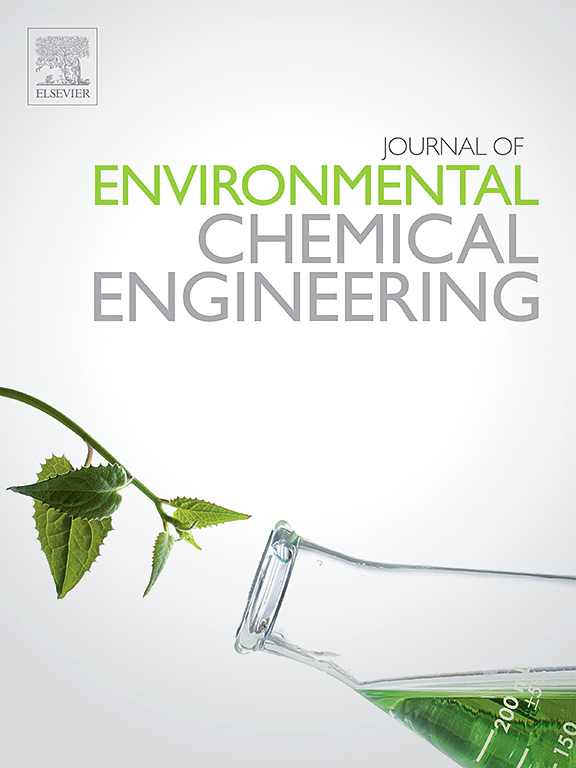IF 7.4
2区 工程技术
Q1 ENGINEERING, CHEMICAL
引用次数: 0
摘要
人们日益关注人为因素对环境的影响,因此环境污染和水质研究日益增多,这些研究表明,污染物普遍具有浓度低、政府监管少的特点。药物是新兴污染物污染的一个重要子类别,包括天然和合成化合物。类固醇是一类显著的药物污染物,因为它们具有高结合亲和力,并能在低浓度下激活信号级联。由于激素类污染物的影响,有必要采取补救措施。由于吸附技术易于实施、成本效益高且具有环境友好的潜力,因此是研究中去除污染物的有利方法。生物衍生吸附材料还具有利用生物材料特性、提高生物兼容性和生物质价值等潜在优势。水凝胶、生物质和生物炭是污染修复研究中最环保的吸附剂,有大量出版物详细介绍了这些材料的良好效果。因此,对近期发表的有关水凝胶、生物质和生物炭用于吸附雌激素(最大的一类类固醇激素)的文章进行回顾,可以对它们的研究结果进行比较。雌酮 (E1)、雌二醇 (E2)、雌三醇 (E3) 和炔雌醇 (EE2) 与其他研究较少的激素(包括泼尼松龙、孕酮、氢化可的松和地塞米松)一起在文献中受到关注。水凝胶对 E1、E2、EE2 和 E3 的去除率从 10 % 到 93 % 不等;生物质对树皮中 E2 和 EE2 的去除率高达 99 %;用废蘑菇基质合成的生物炭对 EE2 的吸附量最高,达到 233 毫克/克。本文章由计算机程序翻译,如有差异,请以英文原文为准。
A review of adsorbents engineered from biological materials developed to remediate estrogen pollution in the environment
Rising concerns over anthropogenic impacts on the environment have increased environmental pollution and water quality research which have demonstrated widespread pollutants characteristics in their low concentrations and few government regulations. Pharmaceuticals are an important subcategory of emerging contaminant pollution which consists of natural and synthetic compounds. Steroids are a notable class of pharmaceutical pollutants due to their high binding affinities and activation of signaling cascades at low concentrations. The impacts of hormonal pollutants necessitate remediation solutions. Adsorption technologies are a favorable method of pollutant removal in research due to the ease of implementation, cost-effectiveness, and potential for environmental friendliness. Biologically derived adsorbent materials offer additional potential benefits of employing properties of biological materials, improving biocompatibility, and valorizing biomass. Hydrogels, biomass, and biochar are some of the most environmentally friendly adsorbents in pollution remediation research and there is a sizable base of publications detailing promising results of these materials. Thus, a review of recent publications of hydrogels, biomass, and biochar applied to adsorb estrogens, the largest class of steroid hormones, will allow their findings to be compared. Estrone (E1), estradiol (E2), estriol (E3), and ethinylestradiol (EE2) were focused on in literature alongside other less-researched hormones including prednisolone, progesterone, hydrocortisone, and dexamethasone. Removal efficiencies of E1, E2, EE2, and E3 by hydrogels ranged from 10 % to 93 %, removal efficiencies of E2 and EE2 with biomasses reached up to 99 % with tree bark, and biochar adsorption peaked in capacity of 233 mg/g of EE2 when synthesized from spent mushroom substrate.
求助全文
通过发布文献求助,成功后即可免费获取论文全文。
去求助
来源期刊

Journal of Environmental Chemical Engineering
Environmental Science-Pollution
CiteScore
11.40
自引率
6.50%
发文量
2017
审稿时长
27 days
期刊介绍:
The Journal of Environmental Chemical Engineering (JECE) serves as a platform for the dissemination of original and innovative research focusing on the advancement of environmentally-friendly, sustainable technologies. JECE emphasizes the transition towards a carbon-neutral circular economy and a self-sufficient bio-based economy. Topics covered include soil, water, wastewater, and air decontamination; pollution monitoring, prevention, and control; advanced analytics, sensors, impact and risk assessment methodologies in environmental chemical engineering; resource recovery (water, nutrients, materials, energy); industrial ecology; valorization of waste streams; waste management (including e-waste); climate-water-energy-food nexus; novel materials for environmental, chemical, and energy applications; sustainability and environmental safety; water digitalization, water data science, and machine learning; process integration and intensification; recent developments in green chemistry for synthesis, catalysis, and energy; and original research on contaminants of emerging concern, persistent chemicals, and priority substances, including microplastics, nanoplastics, nanomaterials, micropollutants, antimicrobial resistance genes, and emerging pathogens (viruses, bacteria, parasites) of environmental significance.
 求助内容:
求助内容: 应助结果提醒方式:
应助结果提醒方式:


